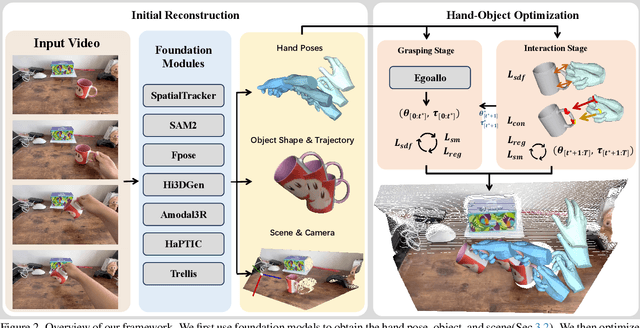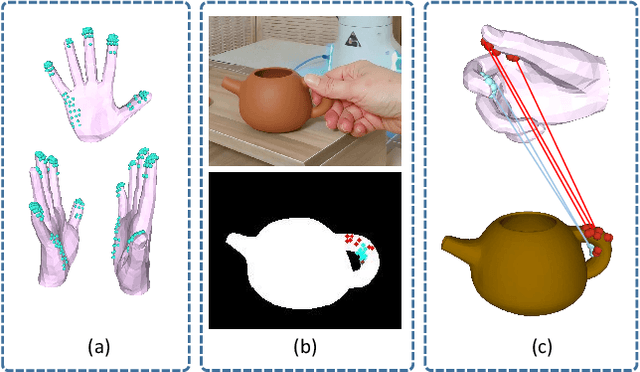Dixuan Lin
Zero-shot Reconstruction of In-Scene Object Manipulation from Video
Dec 22, 2025



Abstract:We build the first system to address the problem of reconstructing in-scene object manipulation from a monocular RGB video. It is challenging due to ill-posed scene reconstruction, ambiguous hand-object depth, and the need for physically plausible interactions. Existing methods operate in hand centric coordinates and ignore the scene, hindering metric accuracy and practical use. In our method, we first use data-driven foundation models to initialize the core components, including the object mesh and poses, the scene point cloud, and the hand poses. We then apply a two-stage optimization that recovers a complete hand-object motion from grasping to interaction, which remains consistent with the scene information observed in the input video.
SkyReels-V2: Infinite-length Film Generative Model
Apr 21, 2025Abstract:Recent advances in video generation have been driven by diffusion models and autoregressive frameworks, yet critical challenges persist in harmonizing prompt adherence, visual quality, motion dynamics, and duration: compromises in motion dynamics to enhance temporal visual quality, constrained video duration (5-10 seconds) to prioritize resolution, and inadequate shot-aware generation stemming from general-purpose MLLMs' inability to interpret cinematic grammar, such as shot composition, actor expressions, and camera motions. These intertwined limitations hinder realistic long-form synthesis and professional film-style generation. To address these limitations, we propose SkyReels-V2, an Infinite-length Film Generative Model, that synergizes Multi-modal Large Language Model (MLLM), Multi-stage Pretraining, Reinforcement Learning, and Diffusion Forcing Framework. Firstly, we design a comprehensive structural representation of video that combines the general descriptions by the Multi-modal LLM and the detailed shot language by sub-expert models. Aided with human annotation, we then train a unified Video Captioner, named SkyCaptioner-V1, to efficiently label the video data. Secondly, we establish progressive-resolution pretraining for the fundamental video generation, followed by a four-stage post-training enhancement: Initial concept-balanced Supervised Fine-Tuning (SFT) improves baseline quality; Motion-specific Reinforcement Learning (RL) training with human-annotated and synthetic distortion data addresses dynamic artifacts; Our diffusion forcing framework with non-decreasing noise schedules enables long-video synthesis in an efficient search space; Final high-quality SFT refines visual fidelity. All the code and models are available at https://github.com/SkyworkAI/SkyReels-V2.
4DHands: Reconstructing Interactive Hands in 4D with Transformers
May 31, 2024Abstract:In this paper, we introduce 4DHands, a robust approach to recovering interactive hand meshes and their relative movement from monocular inputs. Our approach addresses two major limitations of previous methods: lacking a unified solution for handling various hand image inputs and neglecting the positional relationship of two hands within images. To overcome these challenges, we develop a transformer-based architecture with novel tokenization and feature fusion strategies. Specifically, we propose a Relation-aware Two-Hand Tokenization (RAT) method to embed positional relation information into the hand tokens. In this way, our network can handle both single-hand and two-hand inputs and explicitly leverage relative hand positions, facilitating the reconstruction of intricate hand interactions in real-world scenarios. As such tokenization indicates the relative relationship of two hands, it also supports more effective feature fusion. To this end, we further develop a Spatio-temporal Interaction Reasoning (SIR) module to fuse hand tokens in 4D with attention and decode them into 3D hand meshes and relative temporal movements. The efficacy of our approach is validated on several benchmark datasets. The results on in-the-wild videos and real-world scenarios demonstrate the superior performances of our approach for interactive hand reconstruction. More video results can be found on the project page: https://4dhands.github.io.
Cross-Modal Adaptive Dual Association for Text-to-Image Person Retrieval
Dec 04, 2023



Abstract:Text-to-image person re-identification (ReID) aims to retrieve images of a person based on a given textual description. The key challenge is to learn the relations between detailed information from visual and textual modalities. Existing works focus on learning a latent space to narrow the modality gap and further build local correspondences between two modalities. However, these methods assume that image-to-text and text-to-image associations are modality-agnostic, resulting in suboptimal associations. In this work, we show the discrepancy between image-to-text association and text-to-image association and propose CADA: Cross-Modal Adaptive Dual Association that finely builds bidirectional image-text detailed associations. Our approach features a decoder-based adaptive dual association module that enables full interaction between visual and textual modalities, allowing for bidirectional and adaptive cross-modal correspondence associations. Specifically, the paper proposes a bidirectional association mechanism: Association of text Tokens to image Patches (ATP) and Association of image Regions to text Attributes (ARA). We adaptively model the ATP based on the fact that aggregating cross-modal features based on mistaken associations will lead to feature distortion. For modeling the ARA, since the attributes are typically the first distinguishing cues of a person, we propose to explore the attribute-level association by predicting the masked text phrase using the related image region. Finally, we learn the dual associations between texts and images, and the experimental results demonstrate the superiority of our dual formulation. Codes will be made publicly available.
 Add to Chrome
Add to Chrome Add to Firefox
Add to Firefox Add to Edge
Add to Edge